故宫历史中英文简介
- 格式:pptx
- 大小:2.88 MB
- 文档页数:6
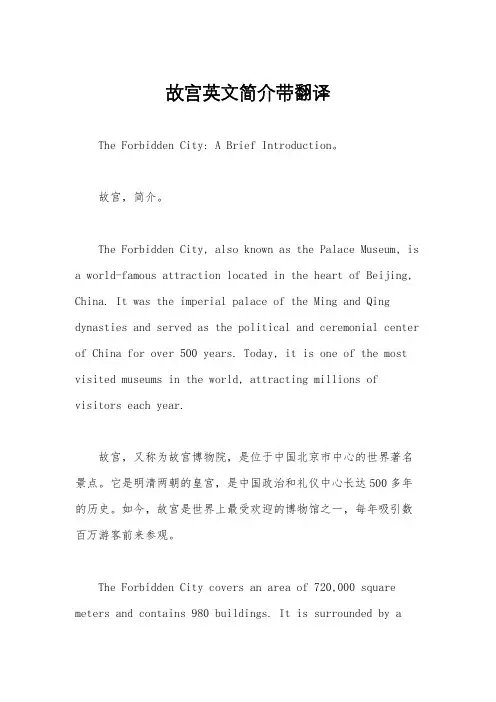
故宫英文简介带翻译The Forbidden City: A Brief Introduction。
故宫,简介。
The Forbidden City, also known as the Palace Museum, is a world-famous attraction located in the heart of Beijing, China. It was the imperial palace of the Ming and Qing dynasties and served as the political and ceremonial center of China for over 500 years. Today, it is one of the most visited museums in the world, attracting millions of visitors each year.故宫,又称为故宫博物院,是位于中国北京市中心的世界著名景点。
它是明清两朝的皇宫,是中国政治和礼仪中心长达500多年的历史。
如今,故宫是世界上最受欢迎的博物馆之一,每年吸引数百万游客前来参观。
The Forbidden City covers an area of 720,000 square meters and contains 980 buildings. It is surrounded by a52-meter-wide moat and a 10-meter-high wall. The palace complex is divided into two parts: the Outer Court, where the emperor held grand ceremonies and conducted state affairs, and the Inner Court, where the emperor and his family lived.故宫占地面积达72万平方米,包括980座建筑。
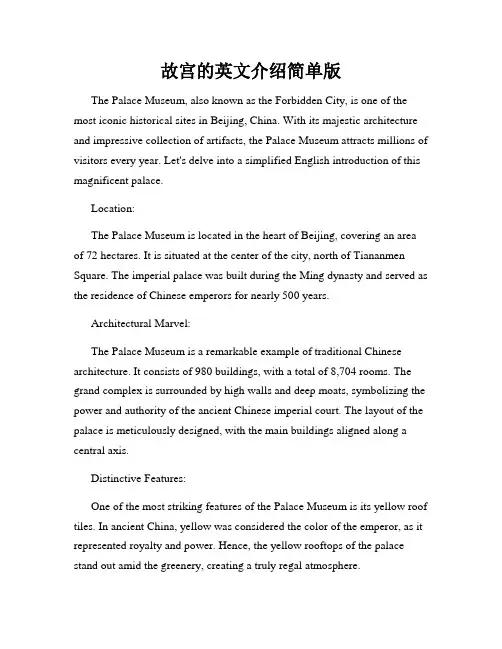
故宫的英文介绍简单版The Palace Museum, also known as the Forbidden City, is one of the most iconic historical sites in Beijing, China. With its majestic architecture and impressive collection of artifacts, the Palace Museum attracts millions of visitors every year. Let's delve into a simplified English introduction of this magnificent palace.Location:The Palace Museum is located in the heart of Beijing, covering an area of 72 hectares. It is situated at the center of the city, north of Tiananmen Square. The imperial palace was built during the Ming dynasty and served as the residence of Chinese emperors for nearly 500 years.Architectural Marvel:The Palace Museum is a remarkable example of traditional Chinese architecture. It consists of 980 buildings, with a total of 8,704 rooms. The grand complex is surrounded by high walls and deep moats, symbolizing the power and authority of the ancient Chinese imperial court. The layout of the palace is meticulously designed, with the main buildings aligned along a central axis.Distinctive Features:One of the most striking features of the Palace Museum is its yellow roof tiles. In ancient China, yellow was considered the color of the emperor, as it represented royalty and power. Hence, the yellow rooftops of the palace stand out amid the greenery, creating a truly regal atmosphere.The palace complex is divided into two main parts: the Outer Court and the Inner Court. The Outer Court consists of three main halls: the Hall of Supreme Harmony, the Hall of Central Harmony, and the Hall of Preserving Harmony. These halls were used for state ceremonies and official affairs during imperial times.The Inner Court, also known as the living quarters of the emperors, is where the royal family resided. The most famous structure in the Inner Court is the Palace of Heavenly Purity, which served as the emperor's living quarters. The beautiful gardens, decorative halls, and exquisite furnishings in the Inner Court reflect the luxurious and opulent lifestyle of the imperial family.Art and Cultural Treasures:Besides its architectural splendor, the Palace Museum houses a vast collection of cultural relics and artworks. The museum boasts over 1.8 million pieces, including rare paintings, calligraphy, ceramics, jade, and precious artifacts from various dynasties.One of the most celebrated treasures is the "Qianlong Emperor's Treasures Reunited" exhibition. This exhibition showcases the remarkable collection of Emperor Qianlong, who was a great art enthusiast. Visitors can admire the intricate craftsmanship of the imperial treasures, gaining insight into the refined tastes of the Qing dynasty rulers.Visiting Tips:To make the most of your visit to the Palace Museum, here are a few handy tips:1. Plan your visit in advance: The Palace Museum is vast, so it's advisable to plan your route and the areas you would like to explore beforehand. This will ensure you can appreciate the highlights without feeling overwhelmed.2. Wear comfortable shoes: The palace grounds are extensive, and you will be doing a lot of walking. It's recommended to wear comfortable shoes to enjoy your visit without discomfort.3. Get an audio guide: To enhance your understanding of the palace's history and significance, consider getting an audio guide or joining a guided tour. This will provide valuable insights into the different sections and buildings you encounter.4. Visit early or late in the day: The Palace Museum can get crowded, especially during peak tourist seasons. To avoid the crowds and long queues, it's best to visit early in the morning or later in the afternoon.The Palace Museum, with its remarkable architecture, rich history, and extensive art collection, offers a captivating glimpse into China's imperial past. Prepare to be mesmerized by its grandeur and immerse yourself in the enchanting world of ancient Chinese emperors. A visit to the Palace Museum is truly an unforgettable experience for history lovers and culture enthusiasts alike.。
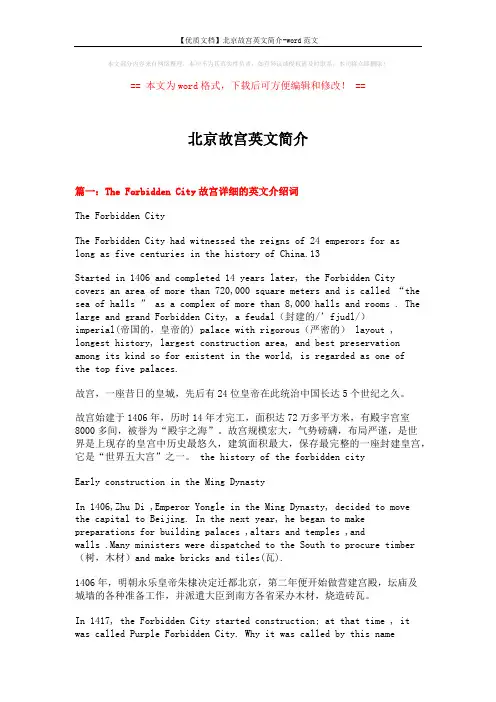
本文部分内容来自网络整理,本司不为其真实性负责,如有异议或侵权请及时联系,本司将立即删除!== 本文为word格式,下载后可方便编辑和修改! ==北京故宫英文简介篇一:The Forbidden City故宫详细的英文介绍词The Forbidden CityThe Forbidden City had witnessed the reigns of 24 emperors for aslong as five centuries in the history of China.13Started in 1406 and completed 14 years later, the Forbidden City covers an area of more than 720,000 square meters and is called “the sea of halls ” as a complex of more than 8,000 halls and rooms . The large and grand Forbidden City, a feudal(封建的/’fjudl/)imperial(帝国的,皇帝的) palace with rigorous(严密的) layout , longest history, largest construction area, and best preservation among its kind so for existent in the world, is regarded as one ofthe top five palaces.故宫,一座昔日的皇城,先后有24位皇帝在此统治中国长达5个世纪之久。
故宫始建于1406年,历时14年才完工,面积达72万多平方米,有殿宇宫室8000多间,被誉为“殿宇之海”。
故宫规模宏大,气势磅礴,布局严谨,是世界是上现存的皇宫中历史最悠久,建筑面积最大,保存最完整的一座封建皇宫,它是“世界五大宫”之一。
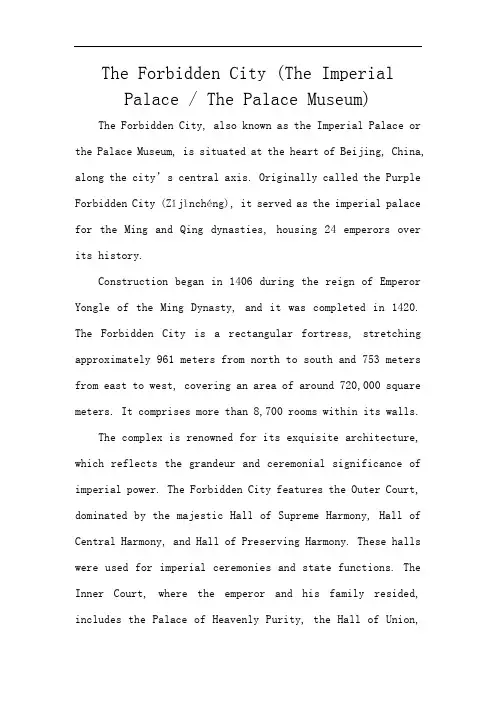
The Forbidden City (The Imperial Palace / The Palace Museum) The Forbidden City, also known as the Imperial Palace or the Palace Museum, is situated at the heart of Beijing, China, along the city’s central axis. Originally called the Purple Forbidden City (Zǐjìnchéng), it served as the imperial palace for the Ming and Qing dynasties, housing 24 emperors over its history.Construction began in 1406 during the reign of Emperor Yongle of the Ming Dynasty, and it was completed in 1420. The Forbidden City is a rectangular fortress, stretching approximately 961 meters from north to south and 753 meters from east to west, covering an area of around 720,000 square meters. It comprises more than 8,700 rooms within its walls.The complex is renowned for its exquisite architecture, which reflects the grandeur and ceremonial significance of imperial power. The Forbidden City features the Outer Court, dominated by the majestic Hall of Supreme Harmony, Hall of Central Harmony, and Hall of Preserving Harmony. These halls were used for imperial ceremonies and state functions. The Inner Court, where the emperor and his family resided, includes the Palace of Heavenly Purity, the Hall of Union,and the Palace of Earthly Tranquility, among other buildings.In 1987, the Forbidden City was inscribed on the UNESCO World Heritage List for its outstanding universal value. Today, the Palace Museum preserves and exhibits countless treasures and artifacts that offer insights into China’s rich cultural heritage. It is one of the world’s m ost visited museums and a significant tourist attraction.。

故宫英文介绍中英对照The Forbidden City, also known as the Palace Museum, is a majestic palace complex located in the heart of Beijing, China. It served as the imperial palace for 24 emperors during the Ming and Qing dynasties, spanning over 500 years of history.Covering an area of 180 acres, the Forbidden City is the largest palace complex in the world. It is surrounded by a 26-foot high wall and a moat that symbolizes protection and security. The complex consists of 980 surviving buildings with over 8,700 rooms, showcasing traditional Chinese architecture and design.The Forbidden City is divided into two main sections: the Outer Court and the Inner Court. The Outer Court was used for ceremonial purposes, where the emperor would meet with officials and foreign dignitaries. The Hall of Supreme Harmony, the Hall of Central Harmony, and the Hall of Preserving Harmony are the main buildings in this section.The Inner Court was the living quarters for the emperor and his family. It includes the Palace of Heavenly Purity, the Hall of Union, and the Palace of Earthly Tranquility. The emperor's living quarters were located here, along with the concubines' quarters and the imperial gardens.The Forbidden City is home to a vast collection of cultural relics and artifacts, including paintings, calligraphy, ceramics, and jade. The Palace Museum houses over 1.8 million pieces of art and artifacts, making it one of the most comprehensive collections of Chinese art in the world.One of the most famous attractions in the Forbidden City is the Hall of Supreme Harmony. This grand hall was used for important ceremonies and events, such as the emperor's enthronement and birthday celebrations. It is the largest building in the complex and is adorned with intricate carvings and decorations.Visitors to the Forbidden City can explore the various halls, pavilions, and courtyards that make up this historic site. The architecture, artwork, and culturalsignificance of the Forbidden City make it a must-see destination for tourists from around the world.In 1987, the Forbidden City was designated a UNESCO World Heritage Site, recognizing its outstanding universal value and historical significance. It continues to be a symbol of China's rich cultural heritage and a testament to the country's imperial past.Overall, the Forbidden City is a remarkable architectural masterpiece that offers a glimpse into China's imperial history and traditions. Its grandeur, beauty, and historical significance make it a must-visit destination for anyone interested in Chinese culture and history.。
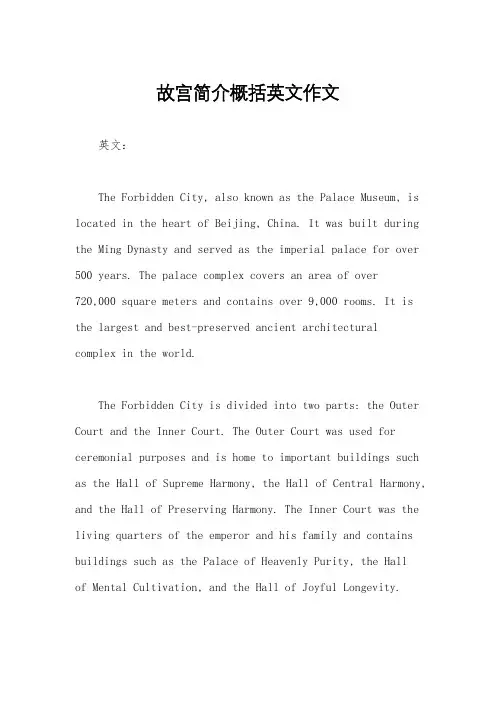
故宫简介概括英文作文英文:The Forbidden City, also known as the Palace Museum, is located in the heart of Beijing, China. It was built during the Ming Dynasty and served as the imperial palace for over 500 years. The palace complex covers an area of over720,000 square meters and contains over 9,000 rooms. It is the largest and best-preserved ancient architectural complex in the world.The Forbidden City is divided into two parts: the Outer Court and the Inner Court. The Outer Court was used for ceremonial purposes and is home to important buildings such as the Hall of Supreme Harmony, the Hall of Central Harmony, and the Hall of Preserving Harmony. The Inner Court was the living quarters of the emperor and his family and contains buildings such as the Palace of Heavenly Purity, the Hallof Mental Cultivation, and the Hall of Joyful Longevity.The Forbidden City is not only a symbol of China's imperial history but also a treasure trove of cultural relics. It houses over 1.8 million pieces of art and artifacts, including paintings, calligraphy, ceramics, and bronze ware. Some of the most famous treasures include the jadeite cabbage, the 12 zodiac animal heads, and the Yongle Encyclopedia.Visiting the Forbidden City is a must-see for anyone interested in Chinese history and culture. It is a UNESCO World Heritage Site and attracts millions of visitors every year.中文:故宫,又称为紫禁城,位于中国北京市中心。
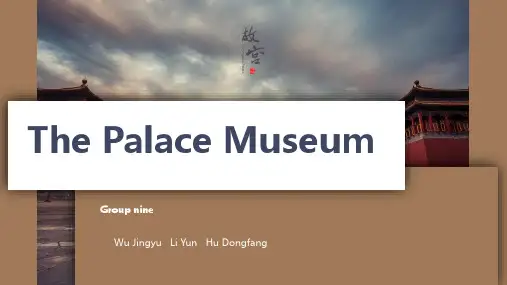
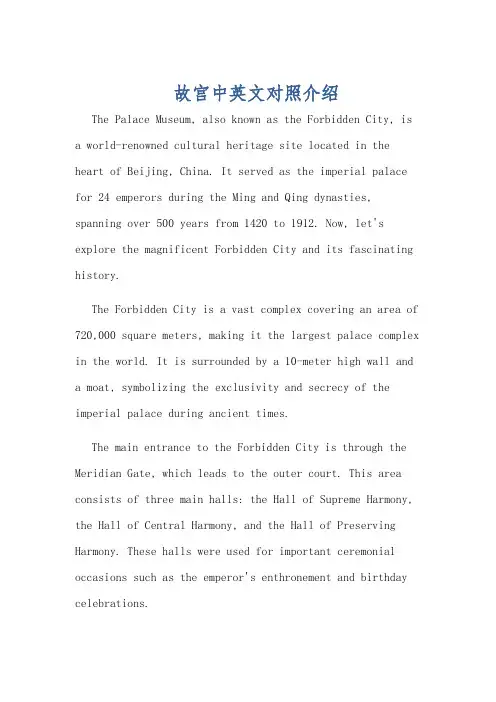
故宫中英文对照介绍The Palace Museum, also known as the Forbidden City, is a world-renowned cultural heritage site located in the heart of Beijing, China. It served as the imperial palace for 24 emperors during the Ming and Qing dynasties, spanning over 500 years from 1420 to 1912. Now, let's explore the magnificent Forbidden City and its fascinating history.The Forbidden City is a vast complex covering an area of 720,000 square meters, making it the largest palace complex in the world. It is surrounded by a 10-meter high wall and a moat, symbolizing the exclusivity and secrecy of the imperial palace during ancient times.The main entrance to the Forbidden City is through the Meridian Gate, which leads to the outer court. This area consists of three main halls: the Hall of Supreme Harmony, the Hall of Central Harmony, and the Hall of Preserving Harmony. These halls were used for important ceremonial occasions such as the emperor's enthronement and birthday celebrations.Moving further into the inner court, you will find the Hall of Heavenly Purity, which served as the emperor'sliving quarters. Adjacent to it is the Hall of Union, where the emperor would handle daily affairs and meet with officials. The most iconic building in the Forbidden Cityis the Palace of Heavenly Purity, which was the residenceof the emperor and his empress.Another significant area in the Forbidden City is the Imperial Garden, located at the northern end of the complex. This garden was designed as a private retreat for the imperial family, with beautiful pavilions, rockeries, and ancient trees. It offers a tranquil oasis amidst the grandeur of the palace.The Forbidden City is not only famous for itsarchitectural splendor but also for its vast collection of cultural artifacts. The Palace Museum houses over 1.8million pieces of art and historical relics, including paintings, calligraphy, ceramics, and jade carvings. These treasures provide valuable insights into Chinese history, art, and culture.Now, let's switch to Chinese to provide a brief introduction to the Forbidden City.故宫,又称为紫禁城,是位于中国北京市中心的世界知名文化遗产。
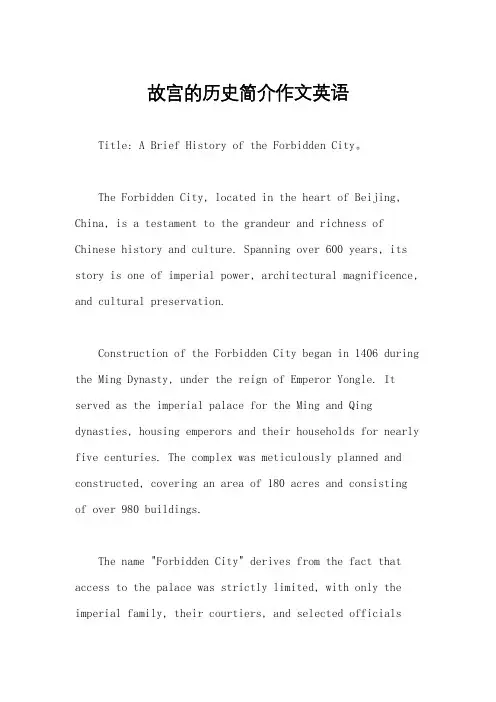
故宫的历史简介作文英语Title: A Brief History of the Forbidden City。
The Forbidden City, located in the heart of Beijing, China, is a testament to the grandeur and richness of Chinese history and culture. Spanning over 600 years, its story is one of imperial power, architectural magnificence, and cultural preservation.Construction of the Forbidden City began in 1406 during the Ming Dynasty, under the reign of Emperor Yongle. It served as the imperial palace for the Ming and Qing dynasties, housing emperors and their households for nearly five centuries. The complex was meticulously planned and constructed, covering an area of 180 acres and consisting of over 980 buildings.The name "Forbidden City" derives from the fact that access to the palace was strictly limited, with only the imperial family, their courtiers, and selected officialspermitted entry. Ordinary citizens were forbidden from entering without special permission, hence the name.Throughout its history, the Forbidden City witnessed the rise and fall of numerous emperors, political intrigue, and cultural shifts. It was the political and ceremonial center of the Chinese government, where important state affairs were conducted and lavish ceremonies held.One of the most significant events in the history of the Forbidden City was its occupation by foreign powers during the late 19th and early 20th centuries. During the Second Opium War in 1860, British and French forces invaded Beijing and looted the palace, causing extensive damage to its treasures. In 1900, during the Boxer Rebellion, the palace was besieged by foreign troops once again. These events marked a tumultuous period in the history of the Forbidden City and China as a whole.Following the fall of the Qing Dynasty in 1912 and the establishment of the Republic of China, the Forbidden City ceased to be the political center of the country. In 1925,it was officially opened to the public as the Palace Museum, allowing visitors to marvel at its architectural splendor and cultural significance.During the 20th century, efforts were made to preserve and restore the Forbidden City to its former glory. Extensive restoration projects were undertaken to repair damage caused by war and neglect, ensuring that this UNESCO World Heritage Site would endure for future generations to appreciate.Today, the Forbidden City stands as one of the most iconic symbols of Chinese civilization, attracting millions of visitors from around the world each year. Its majestic halls, ornate palaces, and sprawling courtyards continue to captivate visitors, offering a glimpse into China'simperial past and rich cultural heritage.In conclusion, the Forbidden City is not merely a collection of buildings; it is a living testament toChina's rich history, cultural identity, and enduring legacy. From its construction during the Ming Dynasty toits status as a UNESCO World Heritage Site, the Forbidden City remains a symbol of China's imperial grandeur and architectural brilliance.。
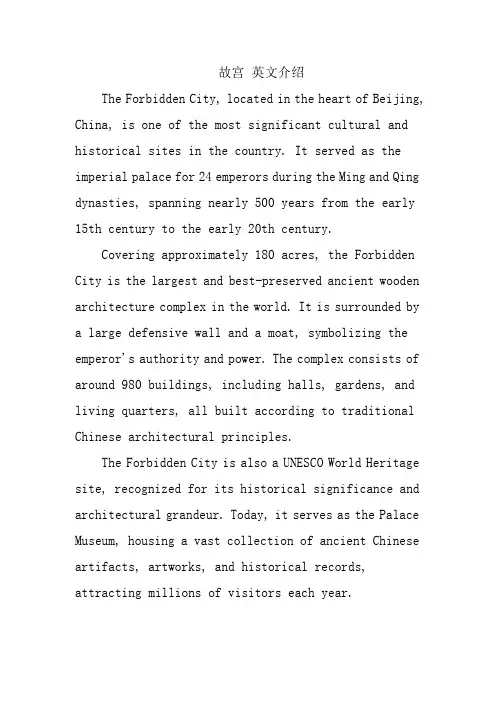
故宫英文介绍The Forbidden City, located in the heart of Beijing, China, is one of the most significant cultural and historical sites in the country. It served as the imperial palace for 24 emperors during the Ming and Qing dynasties, spanning nearly 500 years from the early 15th century to the early 20th century.Covering approximately 180 acres, the Forbidden City is the largest and best-preserved ancient wooden architecture complex in the world. It is surrounded by a large defensive wall and a moat, symbolizing the emperor's authority and power. The complex consists of around 980 buildings, including halls, gardens, and living quarters, all built according to traditional Chinese architectural principles.The Forbidden City is also a UNESCO World Heritage site, recognized for its historical significance and architectural grandeur. Today, it serves as the Palace Museum, housing a vast collection of ancient Chinese artifacts, artworks, and historical records, attracting millions of visitors each year.Visitors to the Forbidden City can explore iconic sites such as the Hall of Supreme Harmony, the Imperial Garden, and the Palace of Heavenly Purity. The intricate designs, vibrant colors, and rich history make it a must-visit destination for anyone interested in Chinese culture and history.中文翻译:故宫位于中国北京的中心,是国家最重要的文化和历史遗址之一。
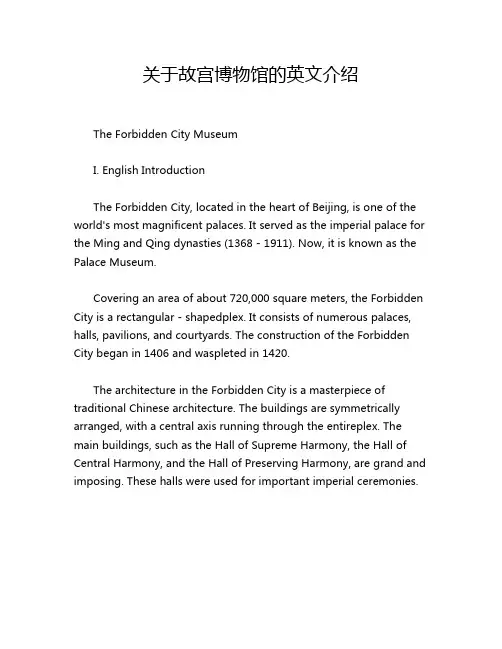
关于故宫博物馆的英文介绍The Forbidden City MuseumI. English IntroductionThe Forbidden City, located in the heart of Beijing, is one of the world's most magnificent palaces. It served as the imperial palace for the Ming and Qing dynasties (1368 - 1911). Now, it is known as the Palace Museum.Covering an area of about 720,000 square meters, the Forbidden City is a rectangular - shapedplex. It consists of numerous palaces, halls, pavilions, and courtyards. The construction of the Forbidden City began in 1406 and waspleted in 1420.The architecture in the Forbidden City is a masterpiece of traditional Chinese architecture. The buildings are symmetrically arranged, with a central axis running through the entireplex. The main buildings, such as the Hall of Supreme Harmony, the Hall of Central Harmony, and the Hall of Preserving Harmony, are grand and imposing. These halls were used for important imperial ceremonies.The Forbidden City also houses a large number of precious cultural relics, including porcelain, calligraphy, paintings, bronzes, and handicrafts. These relics are not only a testament to the high - level craftsmanship of ancient China but also a valuable record of China's long history and culture.In 1987, the Forbidden City was listed as a World Heritage Site by UNESCO, attracting millions of visitors from all over the world every year. It is a must - visit destination for those who want to explore Chinese history and culture.II. English Words and Phrases with Definitions, Usage, and Examples1. Forbidden City- Definition: A large palaceplex in Beijing that was the imperial palace during the Ming and Qing dynasties and is now a museum.- Usage: We visited the Forbidden City last week.- Example: The Forbidden City is a symbol of China's imperial past.2. Palace Museum- Definition: Another name for the Forbidden City, referring to it as a museum now.- Usage: The Palace Museum has a vast collection of cultural relics.- Example: Many touristse to the Palace Museum to admire the ancient art.3. imperial palace- Definition: A palace used by an emperor or an imperial family.- Usage: The imperial palace was the center of political power in the old days.- Example: The imperial palace was filled with luxurious decorations.4. symmetrical- Definition: Having two sides or halves that are the same in size, shape, and position.- Usage: The layout of the Forbidden City is symmetrical.- Example: The symmetrical design gives the building a sense of harmony.5. Hall of Supreme Harmony- Definition: One of the main halls in the Forbidden City, used for important imperial ceremonies such as the enthronement ceremony.- Usage: The Hall of Supreme Harmony is the largest hall in the Forbidden City.- Example: The emperor would hold grand ceremonies in the Hall of Supreme Harmony.6. cultural relics- Definition: Objects of historical, cultural, or archaeological value.- Usage: The Forbidden City preserves a great number of cultural relics.- Example: These cultural relics are carefully protected in the museum.7. porcelain- Definition: A hard, white, shiny ceramic material made by baking clay and used for making delicate tableware, vases, etc.- Usage: The porcelain in the Forbidden City is exquisitely made.- Example: There are many beautiful porcelain pieces on display.8. calligraphy- Definition: The art of writing beautifully, especially with a brush.- Usage: Chinese calligraphy is highly regarded in the Forbidden City's collection.- Example: The calligraphy works in the museum are masterpieces.9. paintings- Definition: Pictures made using paint.- Usage: The Forbidden City has a rich collection of paintings from different dynasties.- Example: These ancient paintings show the unique artistic style of that time.10. bronzes- Definition: Objects made of bronze, an alloy of copper and tin.- Usage: The bronzes in the Forbidden City are of great historical value.- Example: The ancient bronzes are carefully displayed.11. handicrafts- Definition: Objects made by hand, usually with some skill and artistry.- Usage: There are many fine handicrafts in the Forbidden City.- Example: The handicrafts reflect the high - level craftsmanship of ancient artisans.12. World Heritage Site- Definition: A place that is recognized by UNESCO as having outstanding universal value and is protected for the benefit of all humanity.- Usage: The Forbidden City is a well - known World Heritage Site.- Example: As a World Heritage Site, the Forbidden City attracts worldwide attention.13.plex- Definition: A group of buildings or facilities in one place.- Usage: The Forbidden City is a large and magnificentplex.- Example: Theplex includes many different types of buildings.14. rectangular - shaped- Definition: Having the shape of a rectangle.- Usage: The Forbidden City is rectangular - shaped.- Example: The rectangular - shaped layout is very characteristic.15. construction- Definition: The process or work of building something.- Usage: The construction of the Forbidden City took a long time.- Example: The construction techniques used in the Forbidden City are very advanced.16. ceremony- Definition: A formal event with special actions and words performed on a religious or public occasion.- Usage: Many important ceremonies were held in the Forbidden City.- Example: The coronation ceremony was a grand event in the imperial palace.17. testament- Definition: Evidence or proof of something.- Usage: These cultural relics are a testament to China's ancient civilization.- Example: The ancient buildings are a testament to the great architecture skills.18. craftsmanship- Definition: The skill of making things by hand.- Usage: The high - level craftsmanship can be seen in the Forbidden City's artifacts.- Example: The craftsmanship of the porcelain is amazing.19. must - visit- Definition: A place that one should definitely visit.- Usage: The Forbidden City is a must - visit place in Beijing.- Example: For history lovers, it is a must - visit destination.20. admirable- Definition: Deserving praise and respect.- Usage: The architecture of the Forbidden City is admirable.- Example: The grandeur of the Forbidden City is truly admirable.。
如何给外国人介绍故宫英语1. 故宫中英文介绍世界的经典——故宫故宫位于北京市中心。
中国现存最大、最完整的古建筑群。
被誉为世界五大宫之一。
故宫始建于公元1406,故宫有大小院落90多座,房屋有980座,共计8704间。
宫城周围环绕着高12米,长3400米的宫墙,形式为一长方形城池,墙外有52米宽的护城河环绕,形成一个森严壁垒的城堡。
故宫有4个门,正门名午门,东门名东华门,西门名西华门,北门名神武门。
The classic of world-The Palace MuseumThe Palace Museum is located on city center in Peking.China is existing biggest, most integrity of thou building cluster.It is been one of five greatest temples in the world by the fame.The Palace Museum start to set up in A.D.1406, the Palace Museum have the size courtyard more than 90s and the house contain 980 and add up to 8704.the Palace Museum surroundings surround 12 meters in height, long the Palace Museum wall of 3400 meters, form is one rectangular city defense, there is 52 meter wide moat outside the wall surround, formation a fortress of severe barracks.The Palace Museum has 4 doors, center door Wu door, east door Donghua door, west door Xihua door, north door Shengwu door.2. 谁能给我一些有关故宫的英语句子啊The name "purple forbidden city" itself is associated with ancient Chinese philosophy and astrology. The Chineseadvocated a mutual sensing between man and heaven or the integration of man and heaven. So, the structure of the Forbidden City is patterned after the legendary Heavenly Palace. Ancient Chinese astrologers divided the constellation into three parts, which were surrounded by 28 stars. Among them, the Purple Forbidden Enclosure (polar star) was thought to be in the center of the heaven, the center of all stars. Purple in the name refers to the star, meaning that the imperial court was the center of man under heaven. "Forbidden" refers to the living of the imperial family, which was deemed to have supreme dignity that cannot be encroached uponThe Forbidden City is worthy of the name of treasure of the Chinese nation in terms of both materials and architectural art and from its layout to its hidden meanings. Furthermore, it is a storehouse of numerous priceless handicrafts, rare curies, paintings and calligraphic works by famous artists, as well as official documents and historical records. In fact, the City is China's largest museum and biggest treasure houseInside the Forbidden City are more than 10 collection halls: the arts hall of all dynasties, the handicrafts and fine arts hall, the paintings hall, the toy hall of the imperial court of the Qing Dynasty, the bronze objects hall, the porcelain hall, timepiece hall, treasure hall, carvings hall and the hall of furniture of the Ming and Qing Dynasties. They contain about one million pieces, some of which are the only ones of their kind.A Tang Dynasty poet wrote a line about the royal palace of his time, which says “Without seeing the magnificence of the royal palace, one can n ever sense the dignity of the emperor”. Magnificent and awe-inspiring, that is how every visitor would describe the Forbidden City.3. 介绍故宫的英语作文20句话The Palace Museum is also called the Forbidden City,which started to be built in 1407.It took 200,000 people fourteen years to build it.It was finished in 1420.There are 9,999 rooms in all the palaces.In China,nine is regarded as a lucky number traditionally.At present,it is free for Chinese students to visit every Tuesday.The Palace Museum has treasures of over 5,000 years' history.。
故宫(gùgōng)The Palace MuseumForbidden City —the dragon's jewelLocated in the middle of Beijing, the Forbidden City is without dispute the largest and mostgrandiose imperial palace in the world today.From the early years of the Ming Dynasty (1368–1644) to the end of the Qing Dynasty (1644–1911), the palace served as the home of 24 Chinese emperors as well as the political center ofChina's government for nearly 500 years.When Zhu Di, the third emperor of the Ming Dynasty, came to the throne in 1402, he decided tomove the capital from Nanjing, now the capital of Jiangsu Province in east China, to Beijing inorder to better defend the northern territory of the country against tribal invasions.The construction of the Forbidden City started in 1406 andwas completed in 1420. It turned outto be a gargantuan complex with more than 870 buildings and a combined floor space of about8,700 jian(an ancient Chinese spatial unit) or nearly 150,000 square meters.The rectangle-shaped imperial compound covered 720,000 square meters. It is surrounded by ahigh crimson wall and a 52-meter-wide moat.The buildings in the imperial compound, also with crimson walls as well as tall roofs covered withgolden glazed tiles, were almost all built of wood and bricks, with many sitting on extensive andexquisitely carved marble platforms. The wood used in the construction was mostly precious nanmufound in southwest China and the floors of many halls were paved with specially baked"golden" bricks.The beams, columns and rafters in these buildings were exquisitely painted, carved or decorated,particularly withvarious variations of dragon, the symbol of Chinese emperors. The north-south axis of the compound extends all the way to the south to the Tian'anmen GateRostrum and Tian'anmen Square, the center of Beijing today.The compound itself is divided into two parts, with the southern half (called the outer court orthe front court) used by emperors for ceremonial purposes and the northern half (called theinner court or the back palace) serving as the residence of the imperial families as well as the sitefor handling daily affairs of state.Axial symmetryAll buildings, including the most important palaces, in the Forbidden City are arranged along a north-southaxis, symbolizing that the emperor is the center of the world. In addition, the whole city of ancient Beijingwas built along this axis.Of all the buildings in the Forbidden City, the 35-meter-high Taihedian or the Hall of SupremeHarmony is the largest and most majestic. Sitting on a three-tier marble terrace, the hall covers aspace of 30,000 square meters. It was the place where the emperor received officials and exercised his supreme power over the nation.As a result, the Hall of Supreme Harmony had always been deemed as the symbol of supremeimperial power in China during the Ming and Qing dynasties.In addition to dozens of grandiose halls and pavilions, the compound also boasts a privategarden that was specially designed for the imperial family. Covering an area of 12,000 squaremeters, the garden, called Yuhuayuan or Imperial Garden, was filled with ancient trees, exoticrockeries, flowerbeds and bronze incense burners.After the fall of the Qing Dynasty during the 1911 Revolution, the Forbidden City was turned intoa museum. In 1987, it was named a World Heritage Site by UNESCO.The Hall of Supreme HarmonyToday, the Forbidden City is called the Palace Museum, housing more than 1 million items of art,including paintings, pottery, carvings, bronze wares and rare documents. The Forbidden Cityrepresents the pinnacle of ancient Chinese architecture and for several centuries following itscompletion, it exercised great influence over the evolution of architecture not only in China, butalso in many other countries in East Asia. Pictorial dictionary·间(jiān) bayWhen used in terms of buildings or structures,the Chinese character 间"jiān" usually means a room today.But in ancient China, it was used as a basic spatial unit of a building defined by four columns.▲The Inner Golden Water Creek▲Hall of Supreme HarmonyHowever, the distance between two columns or the bay width could vary according to the socialstatus of the owner of a specific building.For instance,for ordinary people,the bay width of their houses usually could not exceed one 丈"zhàng" or about 3.3 meters. And it became wider in houses built for people of higher socialstatus or government ranking.For imperial palaces, such as the Forbidden City in Beijing, the bay width could reach more than1.7 zhang or 5.8 meters.So, when you hear people say that the Forbidden City contains 9,999 and a half jian, it doesn'tmean that there are that many "rooms" in the palace, but rather the term here is used to describethe extremely extensive floor space of the buildings in the imperial compound.。
故宫的英文介绍一句话作文英文,The Forbidden City, also known as the Palace Museum, is a magnificent palace complex located in the heart of Beijing, China. It served as the imperial palace for 24 emperors during the Ming and Qing dynasties, spanning over 500 years of history.中文,故宫,又称为紫禁城,是位于中国北京市中心的一个宏伟的宫殿建筑群。
它曾经是明清两朝24位皇帝的皇宫,跨越了500多年的历史。
As someone who has visited the Forbidden City, I can say that it is truly a breathtaking sight to behold. The sheer size and grandeur of the palace complex is awe-inspiring, and it's hard to imagine how it was all constructed without modern technology.作为一个曾经参观过故宫的人,我可以说它真的是一个惊人的景象。
宫殿建筑群的规模和宏伟是令人敬畏的,很难想象它是如何在没有现代技术的情况下建造的。
One of the most impressive parts of the Forbidden Cityis the Hall of Supreme Harmony, which was used forimportant ceremonies and was the highest-ranking buildingin the palace. The intricate details and decorations on the hall's walls and ceilings are truly remarkable.故宫最令人印象深刻的部分之一是太和殿,它曾用于重要的仪式,是宫殿中最高级别的建筑。
故宫由来与简介英文作文英文:The Forbidden City, also known as the Palace Museum, is located in the heart of Beijing, China. It was the imperial palace of the Ming and Qing dynasties, serving as the home of emperors and their households for over 500 years. The construction of the Forbidden City began in 1406 and was completed in 1420, taking 14 years to complete. It covers an area of 720,000 square meters, with over 9,000 rooms and halls.The Forbidden City was built to symbolize the supreme power of the emperor. It was surrounded by a moat and a 10-meter high wall with watchtowers at each corner. The palace complex consists of three main sections: the Outer Court, the Inner Court, and the Imperial Garden. The Outer Court was where the emperor held grand ceremonies and greeted foreign envoys, while the Inner Court was the private residence of the emperor and his family. The ImperialGarden was a place for the emperor to relax and enjoy nature.The Forbidden City is not only a magnificent architectural wonder, but also a treasure trove of Chinese culture and history. It houses over 1.8 million cultural relics, including paintings, calligraphy, ceramics, jade, and furniture. These relics provide a glimpse into thelives of the emperors and their families, as well as the culture and art of ancient China.As a local Beijinger, I have visited the Forbidden City many times. Every time I go, I am amazed by its grandeur and beauty. One of my favorite places in the Forbidden City is the Hall of Supreme Harmony, where the emperor held important ceremonies and meetings. The hall is supported by 72 massive pillars, and the ceiling is adorned withintricate dragon and phoenix designs. It is truly a masterpiece of ancient Chinese architecture.中文:故宫,也被称为故宫博物院,位于中国北京市中心。
北京故宫历史介绍作文英文The Forbidden City, also known as the Imperial Palace, was the Chinese imperial palace from the Ming dynasty to the end of the Qing dynasty. It is located in the center of Beijing and now houses the Palace Museum. It served as the home of emperors and their households, as well as the ceremonial and political center of Chinese government for almost 500 years.The construction of the Forbidden City began in 1406 and took 14 years to complete. It is a masterpiece of traditional Chinese palatial architecture, covering an area of 180 acres with over 90 palaces and courtyards, 980 buildings, and 8,704 rooms. The complex is surrounded by a 26-foot-high wall and a 170-foot-wide moat.The Forbidden City is a UNESCO World Heritage Site and is the largest collection of preserved ancient wooden structures in the world. It is also home to a vast collection of art and artifacts, including paintings,ceramics, and other treasures of Chinese history and culture.The Forbidden City was the political and ceremonial center of China for over five centuries and is a symbol of the country's imperial history. It is a must-visit for anyone interested in Chinese history and culture, offering a glimpse into the opulent lifestyle of China's emperors and the grandeur of the imperial court.。
故宫历史故事介绍作文英语Title: The Enigmatic Tales of the Forbidden City: A Journey through the History of the Imperial Palace。
Introduction:Nestled in the heart of Beijing lies a treasure trove of history, culture, and intrigue—the Forbidden City. With its majestic architecture, intricate designs, and storied past, it stands as a testament to China's imperial legacy. Embark on a journey with me as we unravel the enigmatic tales of this iconic landmark.The Forbidden City, known in Chinese as Zijin Cheng (紫禁城), served as the imperial palace for over five centuries, housing generations of emperors and their families. Its construction began in 1406 during the Ming Dynasty and was completed fourteen years later, spanning an area of 180 acres and comprising nearly 1,000 buildings.1. The Legend of the Forbidden City's Construction:Legend has it that the construction of the Forbidden City required the labor of over one million workers, including skilled artisans, craftsmen, and laborers. The story goes that massive amounts of gold were used to decorate the palace, earning it the name "Forbidden City" because ordinary people were forbidden to enter its premises.2. The Intriguing Layout of the Forbidden City:Designed with meticulous precision, the layout of the Forbidden City reflects the cosmological principles of ancient China. Its architecture is imbued with symbolism, from the number of buildings to the arrangement of courtyards and halls. The complex is divided into two main parts: the Outer Court, where official ceremonies took place, and the Inner Court, where the emperor resided with his family.3. The Forbidden City's Role in Chinese History:Throughout its history, the Forbidden City witnessedthe rise and fall of numerous dynasties, political intrigue, and cultural upheavals. It served not only as the political center of China but also as a symbol of imperial power and authority. Emperors governed the vast empire from withinits walls, making decisions that shaped the course of history.4. Tales of Intrigue and Betrayal:Behind the grandeur of the Forbidden City lie tales of intrigue, betrayal, and palace politics. Consorts vied for the emperor's favor, eunuchs wielded immense influence, and court officials plotted against each other in their questfor power. These stories offer a glimpse into the complexities of life within the imperial court.5. The Forbidden City Today:Today, the Forbidden City stands as a UNESCO World Heritage Site and a symbol of China's rich culturalheritage. It attracts millions of visitors from around the world who come to marvel at its architectural splendor and learn about its fascinating history. Efforts are underway to preserve and protect this historic treasure for future generations to enjoy.Conclusion:The Forbidden City stands as a testament to China's imperial past, a repository of history, culture, and tradition. Its walls have witnessed the triumphs and tribulations of dynasties long gone, and its halls echo with the whispers of a bygone era. As we journey through its storied halls, we are reminded of the enduring legacy of one of the world's most iconic landmarks.。